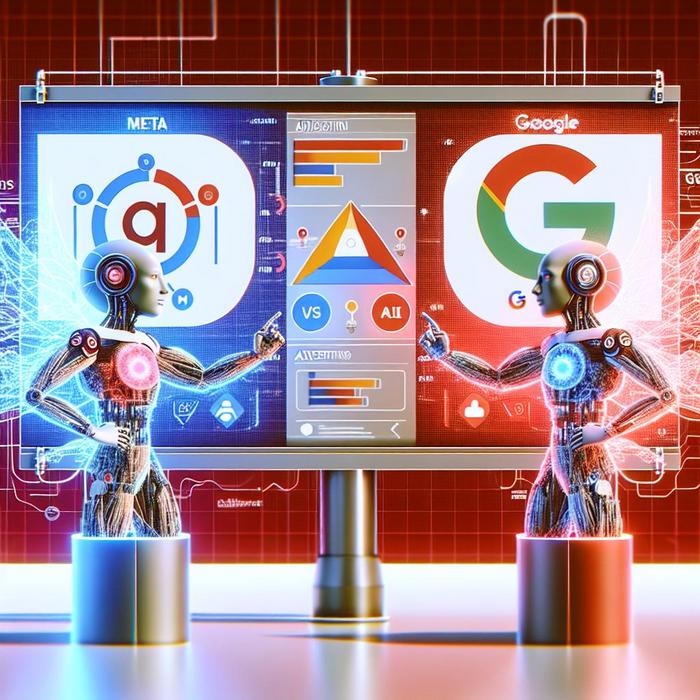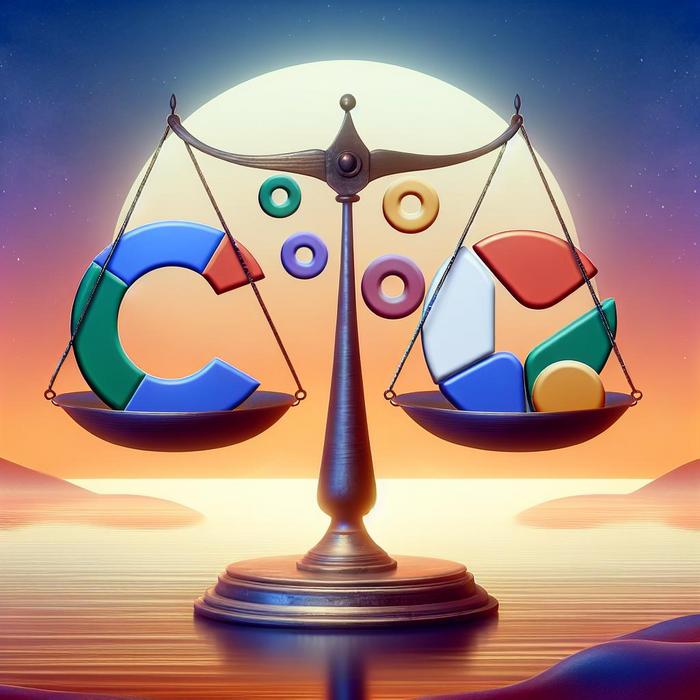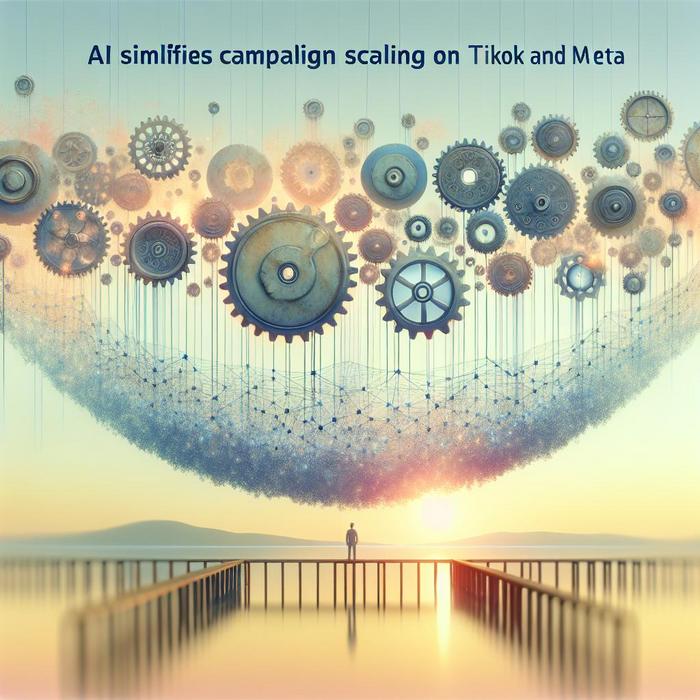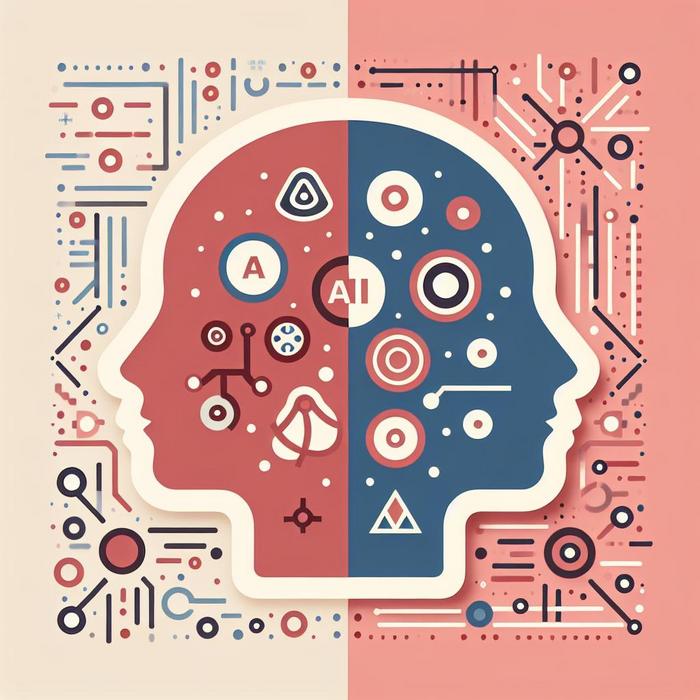Diving Deep into AI Advertising: The Meta and Google Rivalry
Disruptive transformation and radical innovation are the driving forces behind the evolution of digital advertising platforms currently commanded by two giants: Meta and Google. Both have incorporated artificial intelligence (AI) into their strategies, fueling an intense rivalry. As decision-makers, grasping the nuances of both could mean the difference between mediocre and stellar campaign performance.
Meta’s Artificial Intelligence in Digital Advertising
Meta’s sophisticated AI algorithms have revolutionized the advertising industry. The most significant game-changer has been Meta’s high-tech bidding system, focused on increasing the return on investment (ROI) for marketers. This approach allows businesses to reach a highly targeted audience at an optimized cost, removing the guesswork out of campaign management. This tool aligns the intent of your message with the right audience, influencing the decision-making process at a deeper level.
Google’s AI-Powered Path to Maximized ROI
On the other side of the forefront is Google, whose cutting-edge algorithm-driven strategies are a testament to their prowess. The company has invested heavily in machine learning and data analytics capabilities to tailor campaigns for optimal ROI. This approach personalizes advertising efforts with laser precision, ultimately driving higher engagement, conversions, and growth.
Comparing the Giants: Google AI vs Meta AI
While both Meta and Google have their strengths, a strategic comparison can provide powerful insights on where to place your investment.
A science-based study reveals that despite being different platforms, they share the common thread of utilizing machine learning and AI tools for pattern recognition and prediction. However, their methods of execution and emphasis differ.
Meta leans into the social aspect, leveraging user interactions to learn behaviours and preferences. This provides a unique opportunity for brands to build strong connections with their audience. Its ability to serve highly personalized content to users based on their likes, shares and comments, has proven effective in driving user engagement and conversion.
In contrast, Google dives deeper. Their AI exploits search behaviour patterns, making it highly effective for targeting users with high purchase intent. The capacity of Google AI to analyze keyword search patterns and predict user behaviour is unparalleled, offering the potential of converting casual browsers into loyal customers.
Further, both platforms are continually upgrading their AI capabilities. Recently, Google introduced new high tech bidding options, whereas Meta announced their AI-powered retail ad product suite.
Empowering Decision-Makers: Making the Right Choice
The choice between Meta AI and Google AI ultimately boils down to your specific business needs and goals. Whether it’s the social interaction focus of Meta or the search-behaviour driven Google, both provide invaluable tools for AI-based advertising. Keeping pace with the dynamic digital marketing landscape requires strategic decision-making, backed by a thorough understanding of these innovations.
Indeed, the future of digital advertising is exciting. As we continue to explore this ongoing rivalry and its implications, stay tuned for in-depth evaluations, comparisons, and insights that empower you to make the best decisions for your business growth.
Leveraging AI for Precision Targeting
With the rise of AI in advertising, companies can now target individuals with personalized messages at the right time and through the right medium. This precise targeting is made possible by sophisticated AI algorithms that analyze analytics data to accurately profile consumers on a granular level, predicting their behaviors, needs, and motivations. Hence, with data-based profiles in place, marketers can tailor advertisements to resonate more accurately with specific consumer groups, leading not only to increased engagement but potentially higher conversions rates and business growth.
Using its impressive range of data, Meta achieves this precision targeting through a blend of machine learning and behavioral economics, enabling marketers to deliver content that resonates with their audience on a deeply personal level. On the other hand, Google utilizes its surge of search data to hyper-target consumers based on their search behaviors and preferences, ensuring that the ad content hits precisely where it will impact the most.
Monetizing on Data
Both Meta and Google have a treasure trove of user data that they leverage as part of their AI advertising strategies. This data facilitates businesses to monetize their advertising efforts effectively, turning every interaction into an opportunity for revenue generation. The ability to capture and analyze this colossal amount of data in real time, and subsequently use it to adjust the ad experience for users, has been instrumental in shaping the advertising industry. It provides businesses with insightful metrics to understand how their marketing initiatives are performing.
The Role of AI in Customer Segmentation and Ad Optimization
A crucial by-product of AI use in advertising is the ability to segment customers more accurately. This not only enhances efficiency but can also considerably reduce marketing costs while delivering higher ROI. Through cluster analysis, propensity models, and other advanced techniques, AI can quickly and effectively segment populations by demographic, behavioral, and psychographic characteristics, ensuring that each customer is served an ad they’re likely to find interesting and relevant.
The continuous evolution of AI capabilities has made ad optimization comparatively more dynamic and results-driven. Systems can now automatically test numerous ad variations, optimizing them based on real-time performance data. Additionally, by using predictive analytics and machine learning to forecast future behavior based on past data, managers can make more informed decisions about how and where to allocate their advertising budget.
Fostering Creativity in Advertising
Creativity remains a fundamental component in successful advertising campaigns. However, with AI, the scope of what’s achievable and how innovative your campaigns can be has been significantly broadened. AI tools, for instance, both Meta and TikTok’s creative suites, can auto-generate attention-grabbing visuals and catchy copies that resonate with the algorithm’s understanding of your target audience’s preferences. The result? More eye-catching, engaging advertisements that feel personal to each individual viewer.
Read more about TikTok’s creative tools and how they can transform your PPC campaigns.
Final Thoughts
Navigating the landscape of AI advertising is both challenging and exciting. As these powerful enhancements continuously reshape how companies strategize their ad campaigns, the dynamic world of digital advertising is bound to bring more surprises. The key to staying ahead lies in understanding the nuances of AI implementation in your advertising strategies, whether through Meta, Google, or TikTok. And as digital innovation marches on, the ability to pivot and adapt will remain central to the ongoing success of campaigns.
Remember, unlocking the best of AI advertising involves staying receptive to change, consistently evaluating strategies, and continuously looking for ways to align them with evolving business objectives and customer expectations. Your audience is digitally savvy; your strategies should be too. Stay abreast of the latest development in Meta, Google, or TikTok’s AI tools and strategies by subscribing to our regular insights here.
Buckle up for a thrilling ride into the future of digital advertising!









